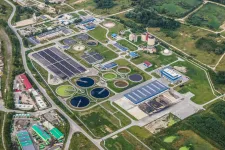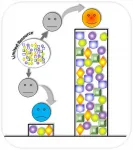(Press-News.org) As part of a worldwide collaboration, Carnegie Mellon University chemists have helped discover that iodic acids can rapidly form aerosol particles in the atmosphere, giving scientists more knowledge of how iodine emissions can contribute to cloud formation and climate change.
"Essentially all uncertainty around climate change and the atmosphere has something to do with particles and cloud droplets," said Neil Donahue, Thomas Lord University Professor of Chemistry and a professor in the departments of Chemical Engineering, and Engineering and Public Policy. The Donahue lab has been a longtime member of the CERN CLOUD experiment, an international collaboration of scientists that use a special chamber at CERN in Switzerland to remedy that uncertainty by studying how cosmic rays affect the formation of particles and clouds in the atmosphere. The chamber allows researchers to precisely mix vaporous compounds and observe how particles form and grow from them.
In a study published today in the journal Science, the CLOUD collaboration looked in particular at how vapors containing iodine affect this nucleation process. For reasons not yet fully understood, Donahue said, concentrations of iodine-containing vapor compounds have been increasing in recent years in the atmosphere.
"This represents a new pathway for particle formation, which in turn governs the properties of clouds in the marine atmosphere," Donahue said.
Building on previous research his lab conducted on discovering a new rapid mechanism for atmospheric particle formation from nitric acid and ammonia vapors, Donahue and his team have now helped the CLOUD collaboration discover that the nucleation rates of iodic acid particles are very fast. This means that increasing concentrations of iodine-containing vapors in the atmosphere can lead to large increases in the number of particles that form clouds.
Specifically, Donahue and his collaborators, including current Ph.D. candidates Mingyi Wang and Victoria Hofbauer, alumna Qing Ye and former postdoctoral scholar Dexian Chen, contributed their use of a state-of-the-art chemical ionization mass spectrometer that can measure the amount and composition of extremely small particles less than 10 nanometers in size just following their formation.
"The CMU measurements showed that the newly formed particles are composed largely of iodic acid, confirming that this critical molecule not only is present as a vapor while particles are forming but definitively drives their growth," Donahue said.
While clouds forming may sound like a relatively benign outcome, clouds play an important role in regulating Earth's temperature because they are highly reflective. Much of the sun's energy is reflected by clouds back into space, keeping Earth from becoming too hot. However, that reflectivity can work both ways, which is a particular problem at Earth's poles. Typically, the white snow and ice surfaces reflect a lot of sunlight back into space, thus keeping the surface there cool. However, increased cloud formation in those regions can mean that the light reflected off the surface can be reflected back onto the ice and snow by the cloud cover.
"The Arctic is an especially vulnerable region, with twice the rate of warming and the huge consequences of both sea ice and ice sheet melting," Donahue said. He and his lab are already planning future research into the complex feedbacks between iodic acid and sulfur compounds and how these affect the polar atmosphere and climate change.
"We have a great deal more to learn in this area, especially regarding the interactions of the iodine compounds and particles, and dimethyl sulfide oxidation and its particle formation," Donahue said.
INFORMATION:
Additional study authors include Xu-Cheng He, Yee Jun Tham, Lubna Dada, Jiali Shen, Birte Rörup, Rima Baalbaki, Tuija Jokinen, Nina Sarnela, Lisa J. Beck, Federico Bianchi, Biwu Chu, Jonathan Duplissy, Juha Kangasluoma, Deniz Kemppainen, Totti Laitinen, Katrianne Lehtipalo, Tuukka Petäjä, Roseline C. Thakur, Yonghong Wang, Yusheng Wu, Chao Yan, Qiaozhi Zha, Putian Zhou, Markku Kulmala, Veli-Matti Kerminen, Theo Kurtén, Douglas R. Worsnop and Mikko Sipilä with the University of Helsinki; Henning Finkenzeller, Theodore K. Koenig, Randall Chiu, Andrea C. Wagner, Roy L. Mauldin and Rainer Volkamer with the University of Colorado; Dominik Stolzenburg, Sophia Brilke, Loïc Gonzalez Carracedo, Christian Tauber, Miguel Vazquez-Pufleau and Paul M. Winkler with the University of Vienna; Siddharth Iyer and Matti Rissanen with Tampere University; Mario Simon, Andreas Kürten, Lucía Caudillo, Manuel Granzin, Martin Heinritzi, Guillaume Marie, Tatjana Müller, Marcel Zauner-Wieczorek and Joachim Curtius with Goethe University; Siegfried Schobesberger, Zijun Li and Arttu Ylisirniö with the University of Eastern Finland; Dongyu S. Wang, Andrea Baccarini, Josef Dommen, Imad El Haddad, Chuan Ping Lee, Ruby Marten, Mao Xiao and Urs Baltensperger with the Paul Scherrer Institute; João Almeida, Hanna E. Manninen, Serge Mathot, Antti Onnela, Joschka Pfeifer, Stefan K. Weber and Jasper Kirkby with CERN's European Organization for Nuclear Research; Stavros Amanatidis, Changhyuk Kim, Weimeng Kong, Benjamin Schulze, Richard C. Flagan with the California Institute of Technology; António Amorim and António Dias with the University of Lisbon; Farnoush Ataei with the Leibniz Institute for Tropospheric Research; Barbara Bertozzi and Ottmar Möhler with the Karlsruhe Institute of Technology; Aijun Ding and Wei Nie with Nanjing University; Armin Hansel, Markus Leiminger, Bernhard Mentler, Wiebke Scholz and Gerhard Steiner with the University of Innsbruck; Heikki Junninen with the University of Tartu; Jordan E. Krechmer with Aerodyne Research; Aleksander Kvashin, Vladimir Makhmutov, Maxim Philippov and Yuri Stozhkov with the Russian Academy of Sciences; Ananth Ranjithkumar with the University of Leeds; Alfonso Saiz-Lopez with the Institute of Physical Chemistry Rocasolano; Imre Salma with Eötvös University; Simone Schuchmann with Johannes Gutenberg University Mainz and António Tomé with the University of Beira Interior.
Funding for this research was provided by Academy of Finland (projects 316114, 307331, 310682, 266388, 3282290, 306853, 296628, 229574, 326948, and 1325656); the European Research Council (projects 692891, 616075, 764991, 316662, 742206, and 714621); CSC - Finnish IT center; the EC Seventh Framework Programme and the EU H2020 programme Marie Sk?odowska Curie ITN "CLOUD-TRAIN" (316662) and "CLOUD-MOTION" (764991); Austrian Science Fund (FWF) (J3951-N36 and P27295-N20); the Swiss National Science Foundation (20FI20_159851, 200021_169090, 200020_172602, and 20FI20_172622); the U.S. National Science Foundation (grants AGS1447056, AGS1439551, AGS1801574, AGS1620530, AGS1801897, AGS153128, AGS1649147, AGS1801280, AGS1602086, and AGS1801329); MSCA H2020 COFUND-FP-CERN-2014 fellowship (665779); German Federal Ministry of Education and Research: CLOUD-16 (01LK1601A); Portuguese Foundation for Science and Technology (CERN/FIS-COM/0014/2017); Academy of Finland Centre of Excellence in Atmospheric Sciences (grant 272041); European Regional Development Fund (project MOBTT42); Estonian Research Council (project PRG714); Hungarian National Research, Development and Innovation Office (K116788 and K132254); NASA Graduate Fellowship (NASANNX16AP36H); and ACTRIS 2TNA H2020 OCTAVE (654109).
Face masks mandates have led people to spend less time at home, but whether this has exposed Americans to more risk is still a question, according to a new study published Thursday in Scientific Reports.
Using anonymized location data from smart devices, the study, conducted by Yale School of the Environment Professor Eli Fenichel, Youpei Yan, YSE postdoctoral associate, Colorado State University Assistant Professor Jude Bayham and Aaron Richter, a Yale research affiliate, examined changes in behavior of residents two weeks before and two weeks after mask mandates were implemented in regions of the United States.
The study found that residents spent between 11-24 more minutes outside their homes after a facemask mandate was issued, even as COVID-19 rates were rising in the U.S. ...
A new study of autism risk genes by UC San Francisco and UC Berkeley scientists implicates disruption in prenatal neurogenesis - a process in which specialized "progenitor" cells give rise to new brain cells - in the development of autism spectrum disorders (ASDs). The study also shows that estrogen, perhaps in a form produced within brain cells, can protect against this disruption and steer the brain on a normal course of development.
The most striking findings in the study, published on January 25, 2021 in Neuron, were derived from experiments using embryos of the western clawed frog (Xenopus tropicalis), a species prized by biologists for the unique insights it offers into development. Human genes involved in development ...
Prompted by the need to improve conventional treatments for people infected with the human immunodeficiency virus (HIV-1), a team from the Institut national de la recherche scientifique (INRS) has identified a therapeutic approach to restore the effectiveness of immune cells. The study, led by doctoral student Hamza Loucif and Professor Julien van Grevenynghe, was published in the journal Autophagy.
Most people infected with HIV-1 require daily antiretroviral therapy to control the infection. These drugs cause significant side effects without fully restoring the normal functioning of the immune system. ...
SPOKANE, Wash. - Diabetic patients taking the natural product goldenseal while taking the prescription drug metformin may be unwittingly sabotaging their efforts to maintain healthy blood glucose levels. This concern arose from a recent study published in the journal Clinical Pharmacology & Therapeutics.
Metformin--the world's most-prescribed oral glucose-lowering medication--was included in a cocktail of selected drugs given to participants in a clinical study led by scientists at Washington State University's College of Pharmacy and Pharmaceutical Sciences. The study sought to determine the impact of goldenseal on specific ...
A new study by scientists at Utrecht University and the United Nations University concludes that about half of global wastewater is treated, rather than the previous estimate of 20%. Despite this promising finding, the authors warn that treatment rates in developing countries are still very low. The study and its dataset were published Open Access in the journal Earth System Science Data.
Humans and factories produce vast quantities of wastewater per day. If not properly collected and treated, wastewater may severely threaten human health and pollute the environment.
144 million swimming pools
The authors use national statistics to estimate volumes of wastewater production, collection, treatment and reuse. "Globally, about 359 ...
Faster speech rate, greater intensity in the middle of the word, and falling pitch at the end of the word: that is the prosody[1] to adopt if one wants to come across as reliable and honest to one's listeners. Scientists from the Science and Technology for Music and Sound laboratory (CNRS/Ircam/Sorbonne Université/Ministère de la Culture)[2] and the Perceptual Systems Laboratory (CNRS/ENS PSL) have conducted a series of experiments[3] to understand how we decide, based on the voice, whether a speaker is honest and confident, or on the contrary dishonest and uncertain. They have also shown that this signature was perceived similarly ...
The sense of hearing is, quite literally, a molecular tightrope act. Turns out, it involves acrobatics as well.
In a paper published in Nature Communications on Feb 8, researchers at Harvard Medical School and Boston Children's Hospital show that a dynamic and delicate connection between two pairs of diminutive protein filaments plays a central role in in hearing.
The tension held by these filaments, together called a tip link, is essential for the activation of sensory cells in the inner ear. The team's analyses reveal that the filaments, which are joined end-to-end, work together like trapeze artists holding ...
COVID-19 has not only caused a temporary drop in global CO2 emissions, it has also reduced the share of power generated by burning coal - a trend that could in fact outlast the pandemic. This is the key result of a new study by a team of economists based in Potsdam and Berlin that looked at COVID-19's impact on the energy system and demand for electricity. Their findings show that the pandemic, while putting a terrible toll on people's lives and the economy, has also opened a window of opportunity to make this current trend of decreasing coal use irreversible: Supported by the right climate policy measures, power sector emissions could decline more rapidly than previously thought.
"Coal has been hit harder by the Corona crisis than other power sources - and the reason is ...
Higher blood pressure at night than in daytime may be a risk factor for Alzheimer's disease in older men. This is suggested by a new study from researchers at Uppsala University, now published in the journal Hypertension.
'Dementia' is an umbrella term used to describe a category of symptoms marked by behavioural changes and gradually declining cognitive and social abilities. Numerous factors, including hypertension (high blood pressure), affect the risk of developing these symptoms.
Under healthy conditions, blood pressure (BP) varies over 24 hours, with lowest values reached at night. Doctors call this nocturnal blood pressure fall 'dipping'. However, in some people, ...
A new process for inserting synthetic gene circuits into host cells, developed by a team of bioengineers at Arizona State University, has broad implications for improving the effectiveness of a range of disease therapies.
Synthetic biology is an interdisciplinary research field that uses engineering principles to create biological components that don't exist in the natural world. These synthetic components mimic naturally evolved organisms, but are customized to fight disease, including cancer.
A paper recently published in Nature Communications, "Winner-Takes-All Resource Competition Redirects Cascading Cell Fate Transitions," outlines how gene circuits can be reconfigured so that they do not overwhelm the host cells.
"We ...



